An Improved Artificial Ecosystem Algorithm for Economic Dispatch with Combined Heat and Power Units
Abstract
1. Introduction
1.1. Motivation
1.2. Literature Survey
1.3. Paper Contribution
- An FDBM is developed in collaboration with an AEA to create a unique MAEA with improved performance.
- The basic AEA and the proposed MAEA have been assessed in solving the ED problem including CHPUs with and without power losses.
- The proposed MAEA shows greater performance compared with several other reported algorithms in the literature.
- Furthermore, the suggested MAEA is stated to be more resilient and stable than the basic AEA.
1.4. Key Segments of the Paper
2. ED Problem with CHPUs
3. Proposed MAEA for Solving the ED Problem with CHPUs
3.1. Artificial Ecosystem Algorithm
3.2. Proposed MAEA with FDBM
4. Simulation Results
- Case 1: Minimization of the fuel costs without loss consideration for the 7-unit system.
- Case 2: Minimization of the fuel costs considering the power losses for the 7-unit system.
- Case 3: Minimization of the fuel costs without loss consideration for the 48-unit system.
- Case 4: Minimization of the fuel costs considering the power losses for the 48-unit system.
4.1. Implementation for Case 1
4.2. Implementation for Case 2
4.3. Implementation for Case 3
4.4. Implementation for Case 4
5. Conclusions
Author Contributions
Funding
Institutional Review Board Statement
Informed Consent Statement
Data Availability Statement
Acknowledgments
Conflicts of Interest
Abbreviations
| AEA | Artificial ecosystem algorithm |
| BCO | Bee colony optimization |
| CHPUs | Combined heat and power units |
| CHPEED | Combined heat and power economic environmental dispatch |
| CSA | Cuckoo search algorithm |
| DE | Differential evolution |
| DRL | Deep reinforcement learning |
| ECSA | Effective cuckoo search algorithm |
| ED | Economic dispatch |
| FDBM | Fitness distance balance model |
| GSA | Gravitational search algorithm |
| HOU | Heat-only unit |
| IGA | Improved genetic algorithm |
| MAs | Metaheuristic algorithms |
| MAEA | Modified artificial ecosystem algorithm |
| MPA | Marine predator algorithm |
| MPHS | Multi-player harmony search |
| MRFO | Manta-ray foraging optimizer |
| MVO | Multi-verse optimizer |
| POU | Power-only unit |
| PSO | particle swarm optimization |
| PV | Photovoltaic |
| SSA | Salp swarm algorithm |
| TVAC-PSO | PSO with time varying acceleration coefficients |
| WVO | Weighted vertices optimization |
| NGU | Number of POUs |
| NHU | Number of HOUs |
| NCHPU | Number of CHPUs |
| Cm(Pgm) | Cost function for POUs |
| Cn(Hgn) | Cost function for HOUs |
| Ck(Pgk,Hgk) | Cost function for CHPUs |
| α1:α5 | Cost coefficients of POUs |
| φ1:φ3 | Cost coefficients of HOUs |
| β1:β6 | Cost coefficients of CHPUs |
| ‘min’ and ‘max’ | Lowest and highest bounds |
| PowerD | Total electric and heat demands |
| HeatD | Total electric and heat demands |
| PLoss | Total losses |
| Bji | Coefficient element in the B-matrix |
References
- Halim, A.H.; Ismail, I.; Das, S. Performance assessment of the metaheuristic optimization algorithms: An exhaustive review. Artif. Intell. Rev. 2021, 54, 3. [Google Scholar] [CrossRef]
- Kazda, K.; Li, X. A critical review of the modeling and optimization of combined heat and power dispatch. Processes 2020, 8, 441. [Google Scholar] [CrossRef]
- Sarhan, S.; Shaheen, A.; El-Sehiemy, R.; Gafar, M. A Multi-Objective Teaching-Learning Studying-Based Algorithm for Large-Scale Dispatching of Combined Electrical Power and Heat Energies. Mathematics 2022, 10, 2278. [Google Scholar] [CrossRef]
- Zhao, J.; Chen, L.; Wang, Y.; Liu, Q. A review of system modeling, assessment and operational optimization for integrated energy systems. Sci. China Inf. Sci. 2021, 64, 9. [Google Scholar] [CrossRef]
- Yu, W.; Li, C.; Yu, X.; Wen, G.; Lü, J. Economic power dispatch in smart grids: A framework for distributed optimization and consensus dynamics. Sci. China Inf. Sci. 2018, 61, 012204. [Google Scholar] [CrossRef]
- Wang, Y.; Li, B.; Yuan, B. Hybrid of comprehensive learning particle swarm optimization and SQP algorithm for large scale economic load dispatch optimization of power system. Sci. China Inf. Sci. 2010, 53, 8. [Google Scholar] [CrossRef]
- Yan, L.; Qu, B.; Zhu, Y.; Qiao, B.; Suganthan, P.N. Dynamic economic emission dispatch based on multi-objective pigeon-inspired optimization with double disturbance. Sci. China Inf. Sci. 2019, 62, 7. [Google Scholar] [CrossRef]
- Wang, K.; Fu, Z.; Xu, Q.; Chen, D.; Wang, L.; Yu, W. Distributed fixed step-size algorithm for dynamic economic dispatch with power flow limits. Sci. China Inf. Sci. 2021, 64, 112202. [Google Scholar] [CrossRef]
- Srivastava, A.; Das, D.K. A new Kho-Kho optimization Algorithm: An application to solve combined emission economic dispatch and combined heat and power economic dispatch problem. Eng. Appl. Artif. Intell. 2020, 94, 103763. [Google Scholar] [CrossRef]
- Ginidi, A.; Elsayed, A.; Shaheen, A.; Elattar, E.; El-Sehiemy, R. An Innovative Hybrid Heap-Based and Jellyfish Search Algorithm for Combined Heat and Power Economic Dispatch in Electrical Grids. Mathematics 2021, 9, 2053. [Google Scholar] [CrossRef]
- Bagherian, M.A.; Mehranzamir, K. A comprehensive review on renewable energy integration for combined heat and power production. Energy Convers. Manag. 2020, 224, 113454. [Google Scholar] [CrossRef]
- Al-Bahrani, L.; Seyedmahmoudian, M.; Horan, B.; Stojcevski, A. Solving the real power limitations in the dynamic economic dispatch of large-scale thermal power units under the effects of valve-point loading and ramp-rate limitations. Sustainability 2021, 13, 1274. [Google Scholar] [CrossRef]
- Li, L.; He, D.; Jin, J.; Yu, B.; Gao, X. Multi-objective load dispatch control of biomass heat and power cogeneration based on economic model predictive control. Energies 2021, 14, 762. [Google Scholar] [CrossRef]
- Jiang, Y.; Wan, C.; Botterud, A.; Song, Y.; Shahidehpour, M. Convex Relaxation of Combined Heat and Power Dispatch. IEEE Trans. Power Syst. 2021, 36, 2. [Google Scholar] [CrossRef]
- Beigvand, S.D.; Abdi, H.; la Scala, M. Combined heat and power economic dispatch problem using gravitational search algorithm. Electr. Power Syst. Res. 2016, 133, 160–172. [Google Scholar] [CrossRef]
- Mehdinejad, M.; Mohammadi-Ivatloo, B.; Dadashzadeh-Bonab, R. Energy production cost minimization in a combined heat and power generation systems using cuckoo optimization algorithm. Energy Effic. 2016, 10, 81–96. [Google Scholar] [CrossRef]
- Zhou, S.; Hu, Z.; Gu, W.; Jiang, M.; Chen, M.; Hong, Q.; Booth, C. Combined heat and power system intelligent economic dispatch: A deep reinforcement learning approach. Int. J. Electr. Power Energy Syst. 2020, 120, 106016. [Google Scholar] [CrossRef]
- Kim, M.J.; Kim, T.S.; Flores, R.J.; Brouwer, J. Neural-network-based optimization for economic dispatch of combined heat and power systems. Appl. Energy 2020, 265, 114785. [Google Scholar] [CrossRef]
- Ginidi, A.R.; Elsayed, A.M.; Shaheen, A.M.; Elattar, E.E.; El-Sehiemy, R.A. A Novel Heap based Optimizer for Scheduling of Large-scale Combined Heat and Power Economic Dispatch. IEEE Access 2021, 9, 83695–83708. [Google Scholar] [CrossRef]
- Ara, A.L.; Shahi, N.M.; Nasir, M. CHP Economic Dispatch Considering Prohibited Zones to Sustainable Energy Using Self-Regulating Particle Swarm Optimization Algorithm. Iran. J. Sci. Technol. Trans. Electr. Eng. 2020, 44, 1147–1164. [Google Scholar] [CrossRef]
- Zou, D.; Gong, D. Differential evolution based on migrating variables for the combined heat and power dynamic economic dispatch. Energy 2020, 238, 121664. [Google Scholar] [CrossRef]
- Mellal, M.A.; Williams, E.J. Cuckoo optimization algorithm with penalty function and binary approach for combined heat and power economic dispatch problem. Energy Rep. 2020, 6, 2720–2723. [Google Scholar] [CrossRef]
- Shaheen, A.M.; Elsayed, A.M.; Ginidi, A.R.; L-Sehiemy, R.A.E.; Alharthi, M.M.; Ghoneim, S.S.M. A novel improved marine predators algorithm for combined heat and power economic dispatch problem. Alex. Eng. J. 2022, 61, 1834–1851. [Google Scholar] [CrossRef]
- Nazari-Heris, M.; Mohammadi-Ivatloo, B.; Gharehpetian, G.B. A comprehensive review of heuristic optimization algorithms for optimal combined heat and power dispatch from economic and environmental perspectives. Renew. Sustain. Energy Rev. 2018, 81, 2128–2143. [Google Scholar] [CrossRef]
- Shaheen, A.M.; El-Sehiemy, R.A.; Elattar, E.; Ginidi, A.R. An Amalgamated Heap and Jellyfish Optimizer for economic dispatch in Combined heat and power systems including N-1 Unit outages. Energy 2022, 246, 123351. [Google Scholar] [CrossRef]
- Zhao, W.; Wang, L.; Zhang, Z. Artificial ecosystem-based optimization: A novel nature-inspired meta-heuristic algorithm. Neural Comput. Appl. 2020, 32, 9383–9425. [Google Scholar] [CrossRef]
- Shaheen, A.; Elsayed, A.; Ginidi, A.; El-Sehiemy, R.; Elattar, E. Reconfiguration of electrical distribution network-based DG and capacitors allocations using artificial ecosystem optimizer: Practical case study. Alex. Eng. J. 2022, 61, 6105–6118. [Google Scholar] [CrossRef]
- Verma, A.S.; Choudhary, A.; Tiwari, S. Regression test suite minimization using modified artificial ecosystem optimization algorithm. J. Inf. Technol. Manag. 2021, 13, 22–41. [Google Scholar] [CrossRef]
- Niu, Y.; Yan, X.; Wang, Y.; Niu, Y. Dynamic opposite learning enhanced artificial ecosystem optimizer for IIR system identification. J. Supercomput. 2022, 78, 11. [Google Scholar] [CrossRef]
- Omotoso, H.O.; Al-Shaalan, A.M.; Farh, H.M.H.; Al-Shamma, A.A. Techno-Economic Evaluation of Hybrid Energy Systems Using Artificial Ecosystem-Based Optimization with Demand Side Management. Electronics 2022, 11, 204. [Google Scholar] [CrossRef]
- Elkholy, M.M.; El-Hameed, M.A.; El-Fergany, A.A. Artificial ecosystem-based optimiser to electrically characterise PV generating systems under various operating conditions reinforced by experimental validations. IET Renew. Power Gener. 2021, 15, 3. [Google Scholar] [CrossRef]
- Rizk-Allah, R.M.; El-Fergany, A.A. Artificial ecosystem optimizer for parameters identification of proton exchange membrane fuel cells model. Int. J. Hydrog. Energy 2021, 46, 75. [Google Scholar] [CrossRef]
- Sonmez, Y.; Duman, S.; Kahraman, H.T.; Kati, M.; Aras, S.; Guvenc, U. Fitness-distance balance based artificial ecosystem optimisation to solve transient stability constrained optimal power flow problem. J. Exp. Theor. Artif. Intell. 2022, 1–40. [Google Scholar] [CrossRef]
- Shaheen, A.M.; Ginidi, A.R.; El-Sehiemy, R.A.; Elattar, E.E. Optimal economic power and heat dispatch in Cogeneration Systems including wind power. Energy 2021, 225, 120263. [Google Scholar] [CrossRef]
- El-Sehiemy, R.; Shaheen, A.; Ginidi, A.; Elhosseini, M. A Honey Badger Optimization for Minimizing the Pollutant Environmental Emissions-Based Economic Dispatch Model Integrating Combined Heat and Power Units. Energies 2022, 15, 7603. [Google Scholar] [CrossRef]
- El-Sehiemy, R.; Hamida, M.A.; Elattar, E.; Shaheen, A.; Ginidi, A. Nonlinear Dynamic Model for Parameter Estimation of Li-Ion Batteries Using Supply-Demand Algorithm. Energies 2022, 15, 4556. [Google Scholar] [CrossRef]
- Basu, M. Combined heat and power economic emission dispatch using nondominated sorting genetic algorithm-II. Int. J. Electr. Power Energy Syst. 2013, 53, 135–141. [Google Scholar] [CrossRef]
- Mohammadi-Ivatloo, B.; Moradi-Dalvand, M.; Rabiee, A. Combined heat and power economic dispatch problem solution using particle swarm optimization with time varying acceleration coefficients. Electr. Power Syst. Res. 2013, 95, 9–18. [Google Scholar] [CrossRef]
- Zou, D.; Li, S.; Kong, X.; Ouyang, H.; Li, Z. Solving the combined heat and power economic dispatch problems by an improved genetic algorithm and a new constraint handling strategy. Appl. Energy 2019, 237, 646–670. [Google Scholar] [CrossRef]
- Nguyen, T.T.; Nguyen, T.T.; Vo, D.N. An effective cuckoo search algorithm for large-scale combined heat and power economic dispatch problem. Neural Comput. Appl. 2017, 30, 3545–3564. [Google Scholar] [CrossRef]
- Shaabani, Y.a.; Seifi, A.R.; Kouhanjani, M.J. Stochastic multi-objective optimization of combined heat and power economic/emission dispatch. Energy 2017, 141, 1892–1904. [Google Scholar] [CrossRef]
- Shi, B.; Yan, L.X.; Wu, W. Multi-objective optimization for combined heat and power economic dispatch with power transmission loss and emission reduction. Energy 2013, 56, 135–143. [Google Scholar] [CrossRef]
- Roy, P.K.; Paul, C.; Sultana, S. Oppositional teaching learning based optimization approach for combined heat and power dispatch. Int. J. Electr. Power Energy Syst. 2014, 57, 392–403. [Google Scholar] [CrossRef]
- Dolatabadi, S.; El-Sehiemy, R.A.; Zadeh, S.G. Scheduling of combined heat and generation outputs in power systems using a new hybrid multi-objective optimization algorithm. Neural Comput. Appl. 2020, 32, 10741–10757. [Google Scholar] [CrossRef]
- Basu, M. Bee colony optimization for combined heat and power economic dispatch. Expert Syst. Appl. 2011, 38, 13527–13531. [Google Scholar] [CrossRef]
- Basu, M. Combined heat and power economic dispatch by using differential evolution. Electr. Power Compon. Syst. 2010, 38, 996–1004. [Google Scholar] [CrossRef]
- Shaheen, A.M.; Ginidi, A.R.; El-Sehiemy, R.A.; Ghoneim, S.S.M. Economic Power and Heat Dispatch in Cogeneration Energy Systems Using Manta Ray Foraging Optimizer. IEEE Access 2020, 8, 208281–208295. [Google Scholar] [CrossRef]
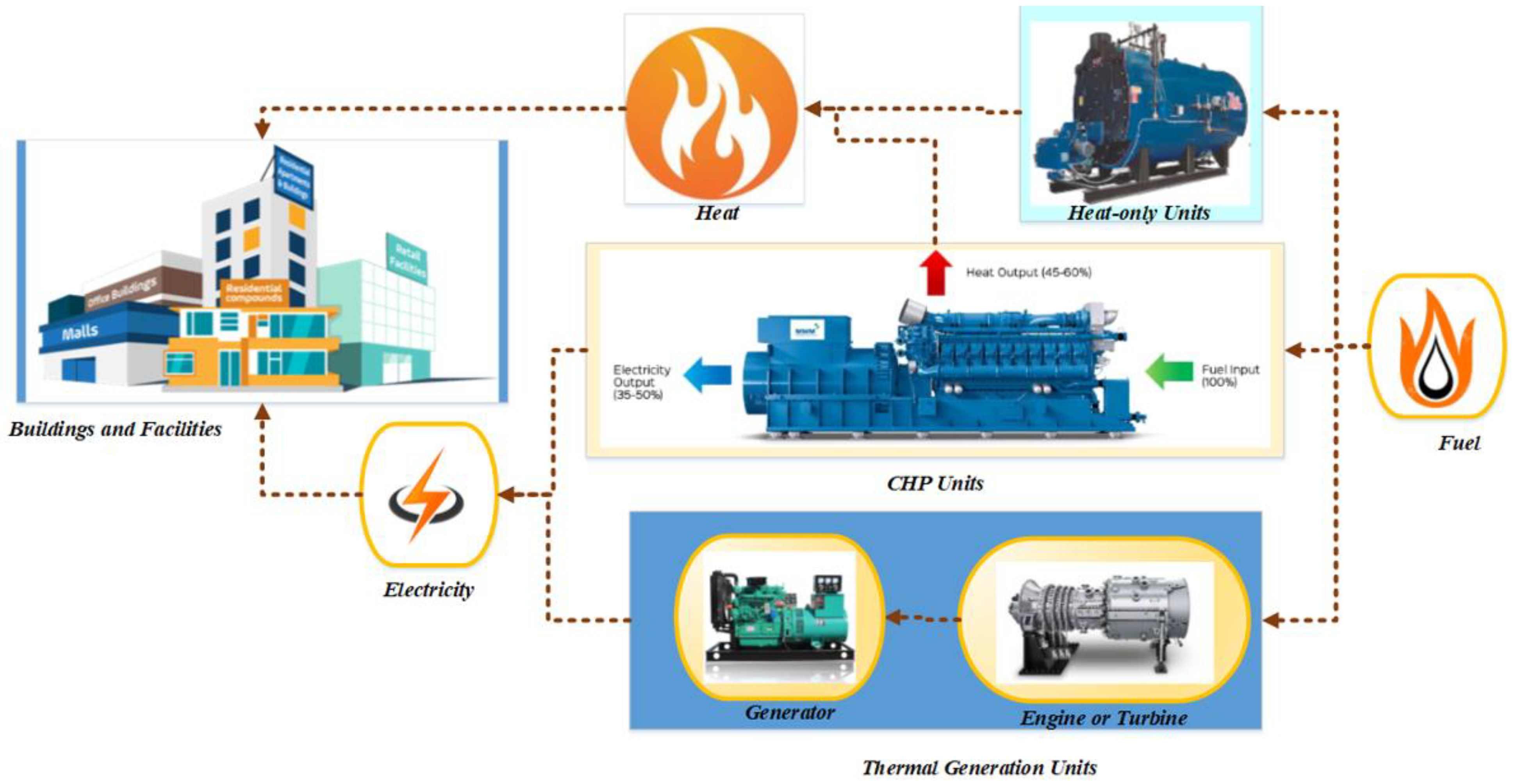


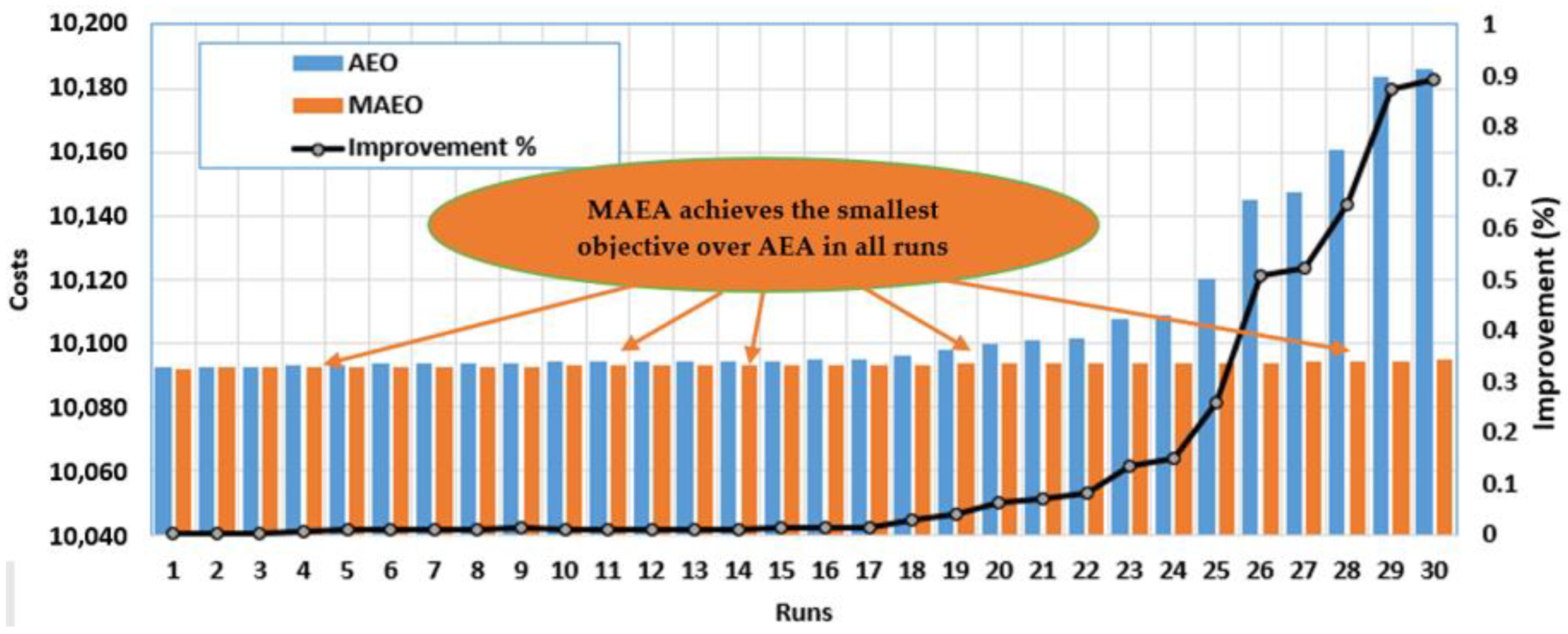
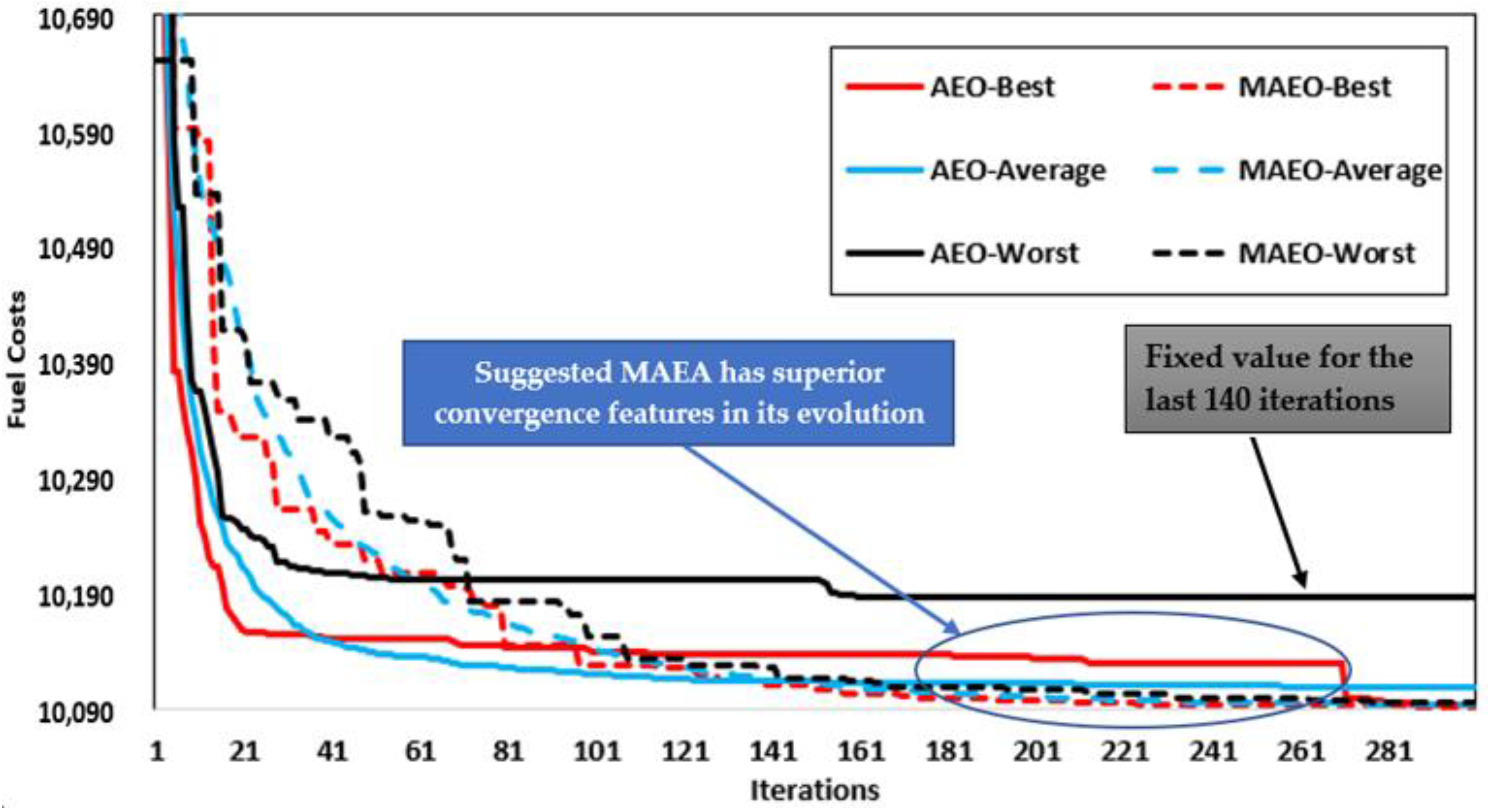
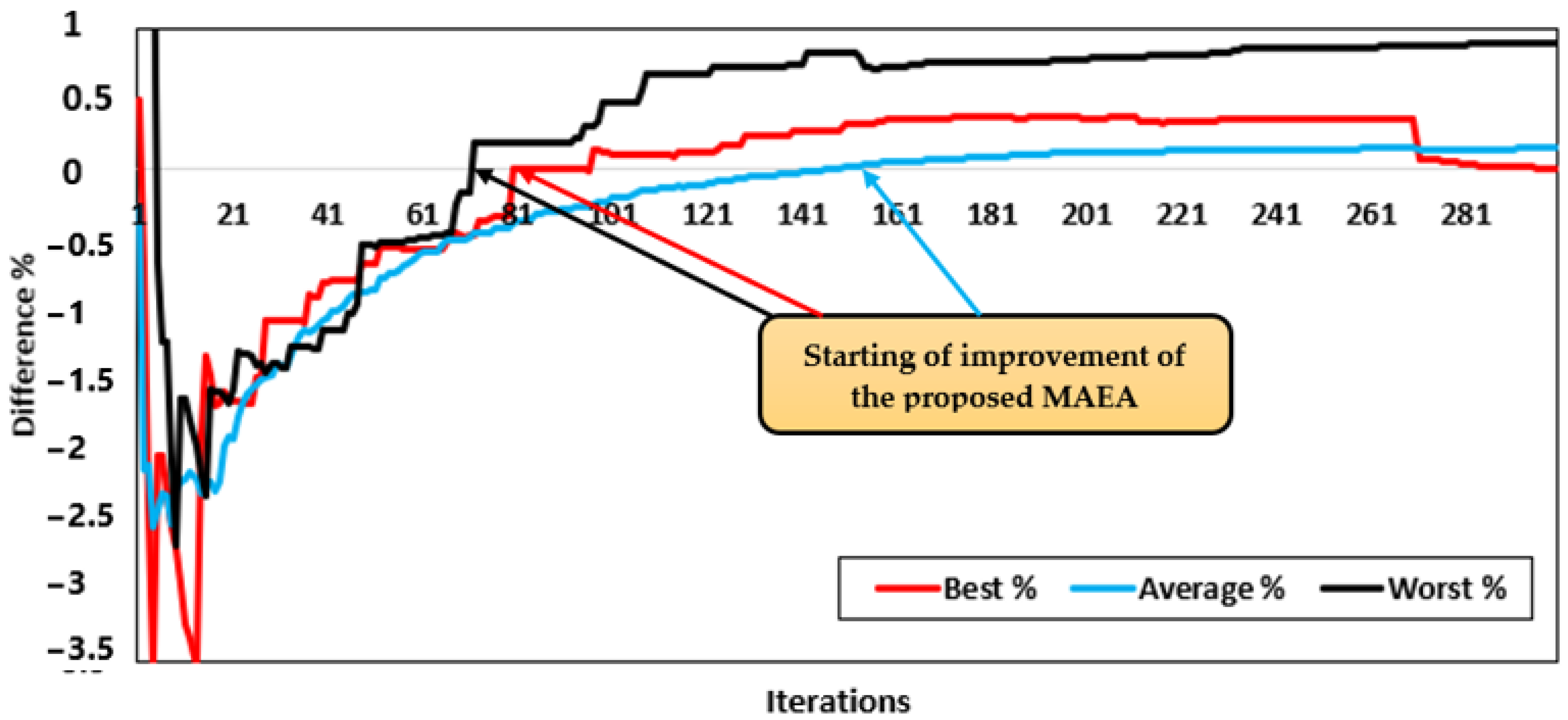
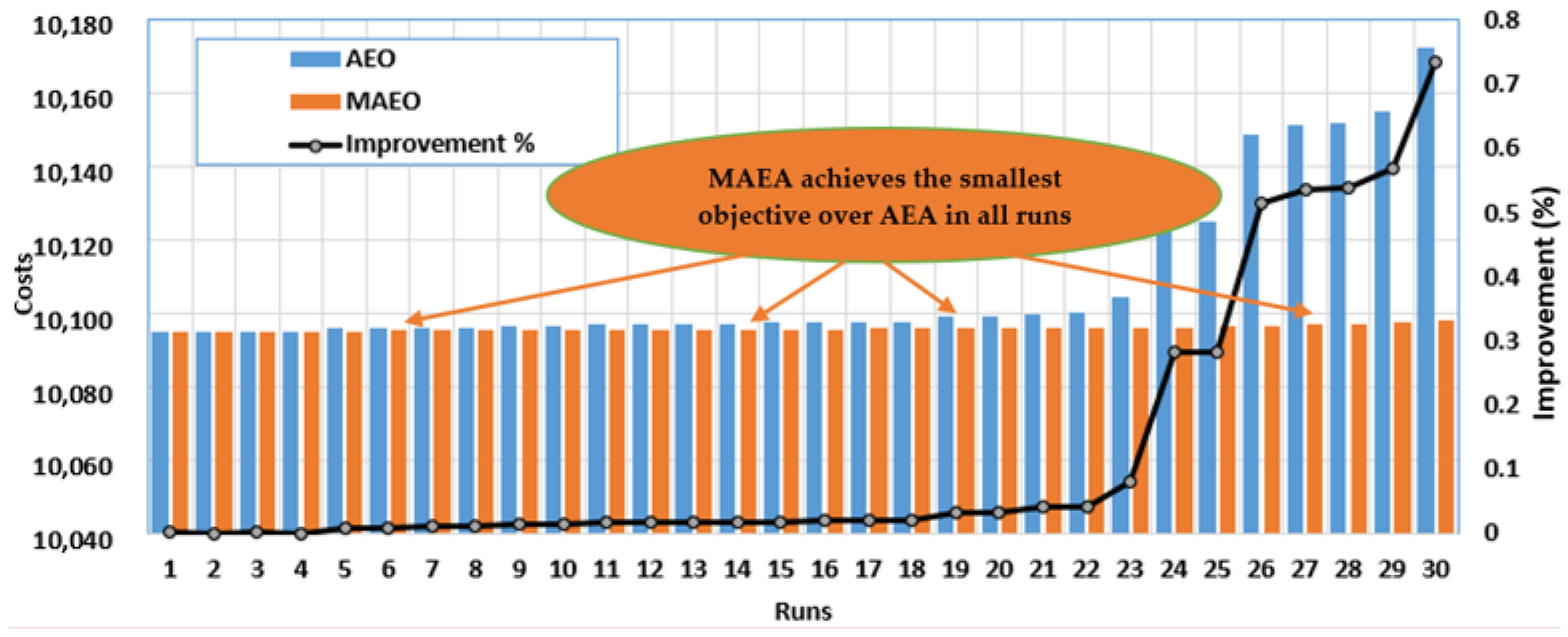
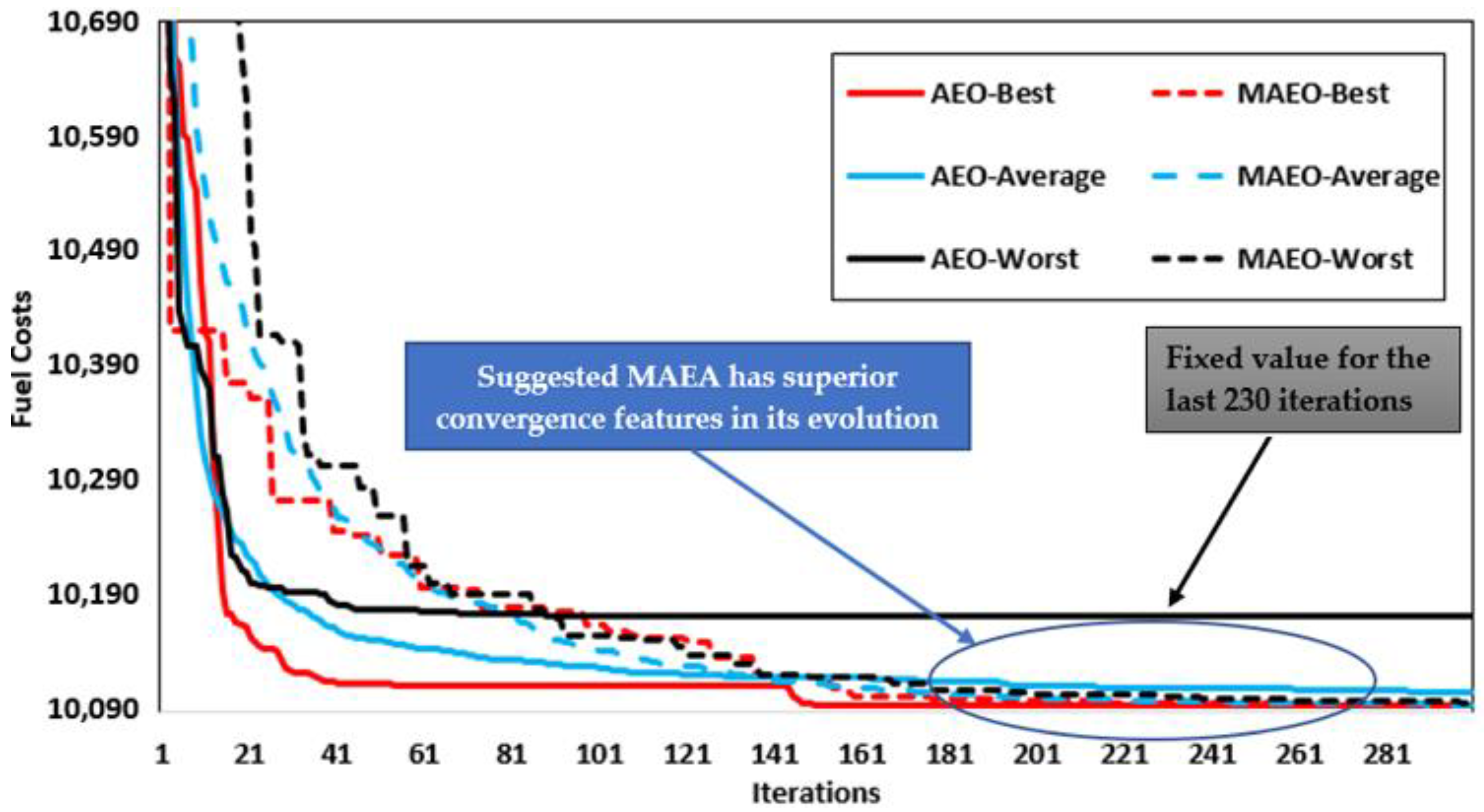
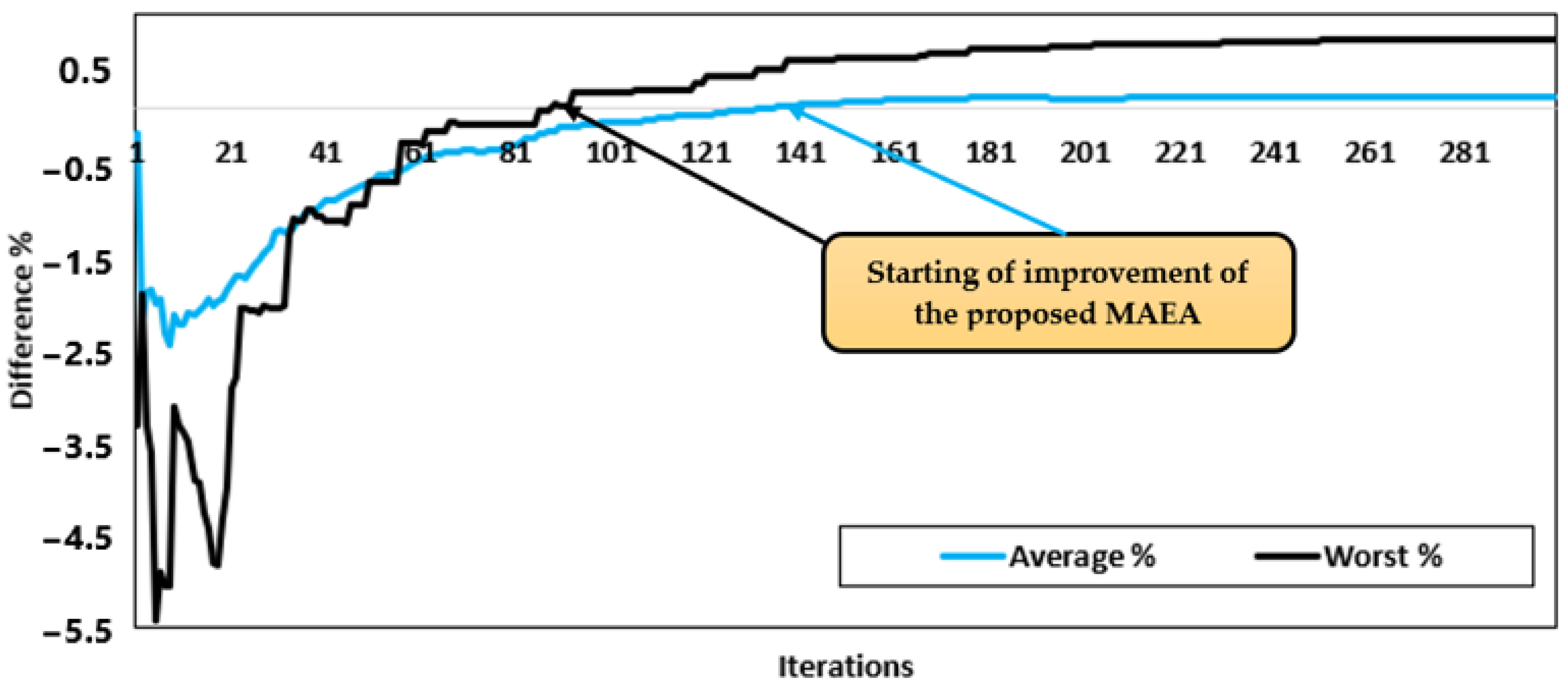

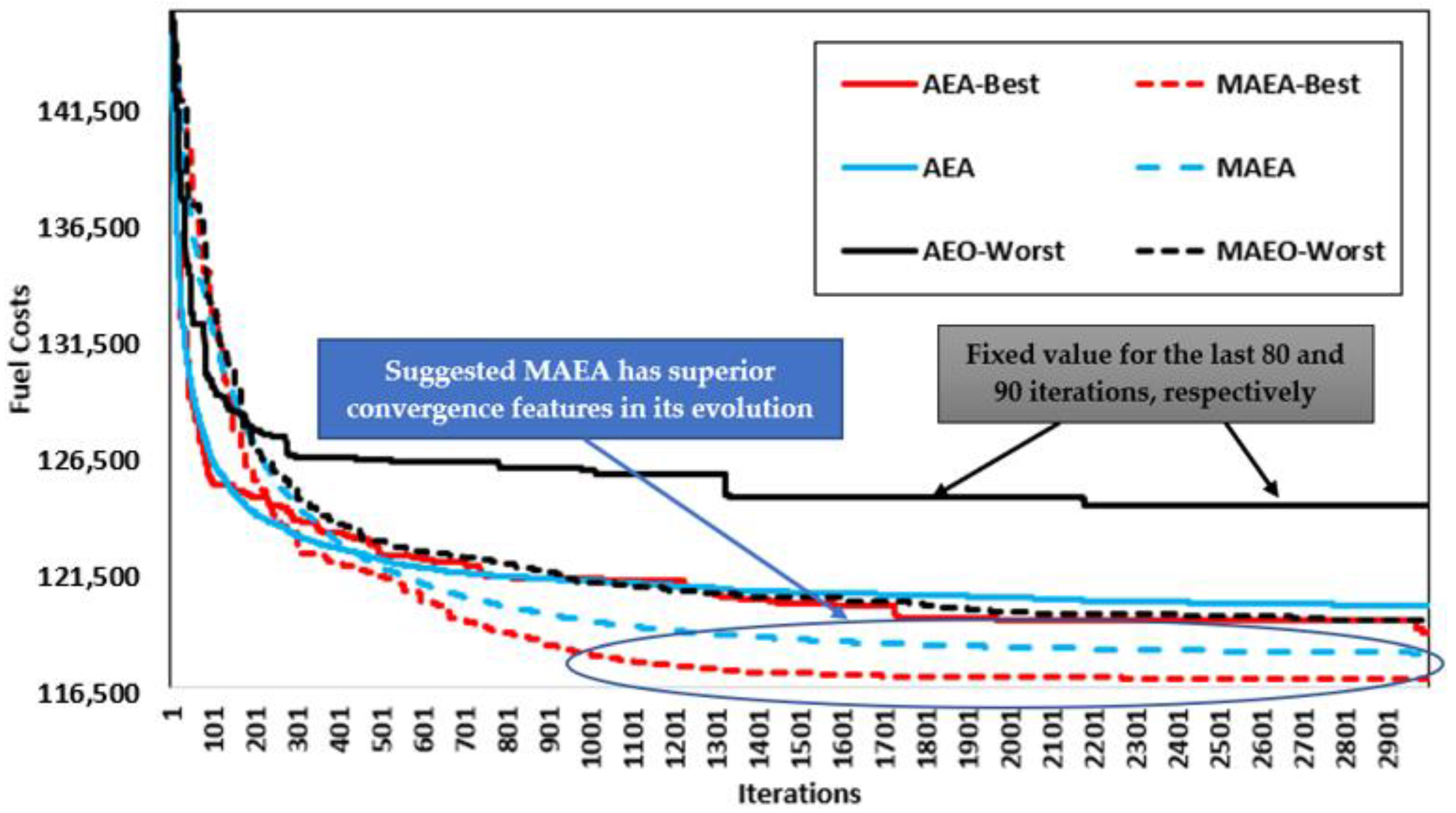
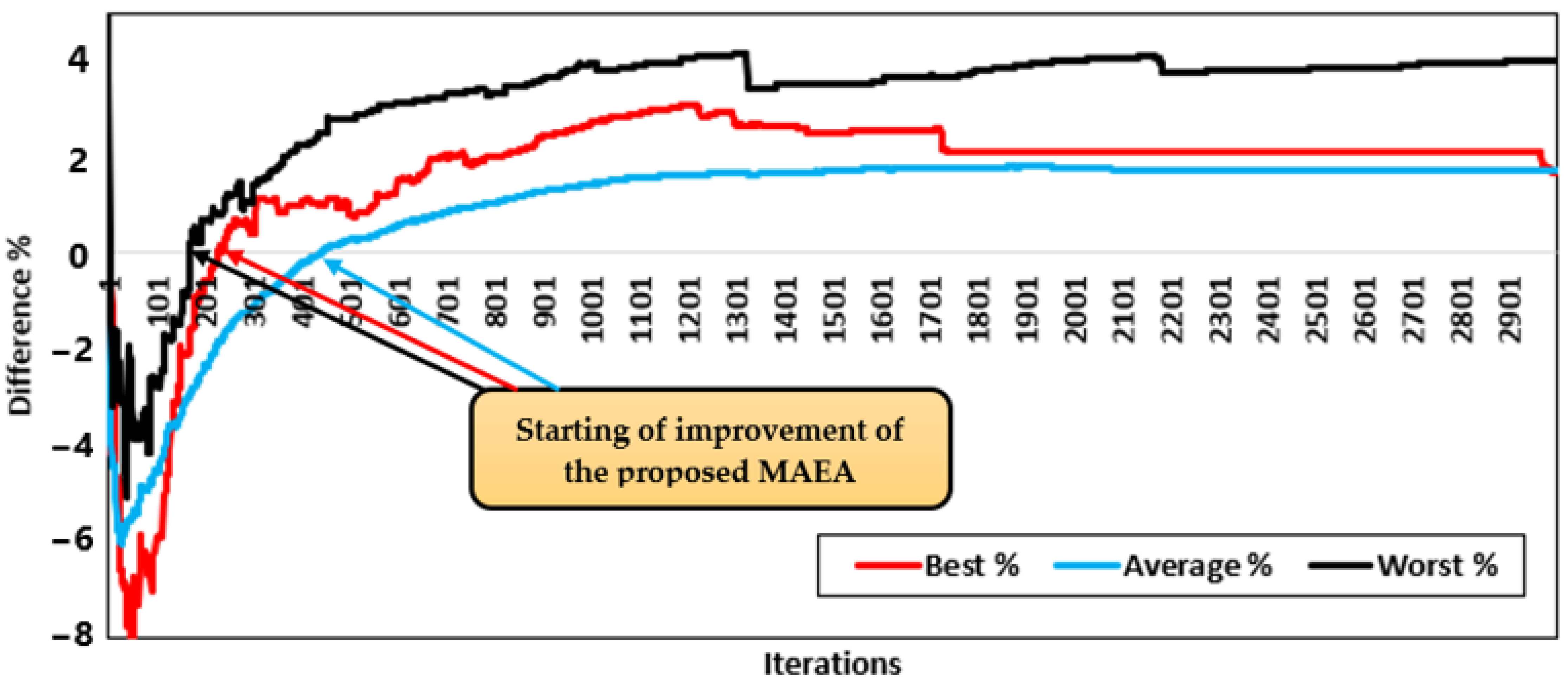
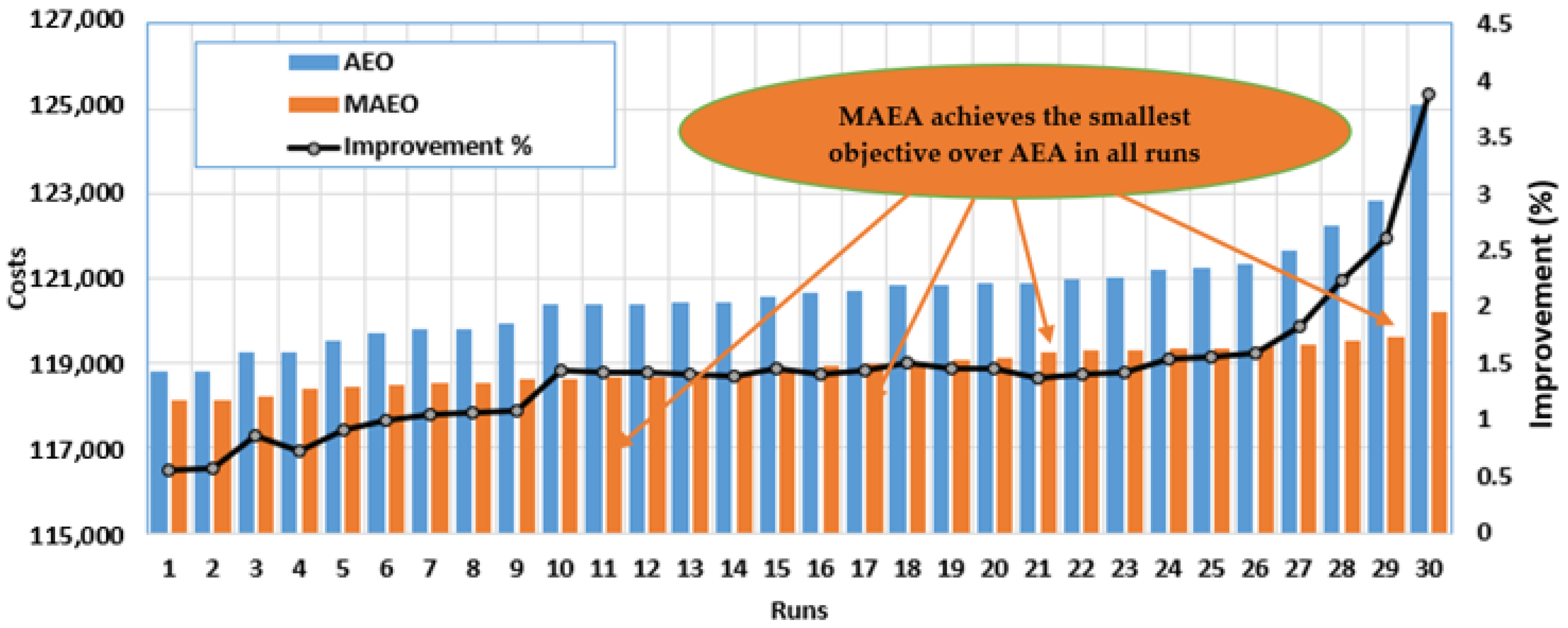
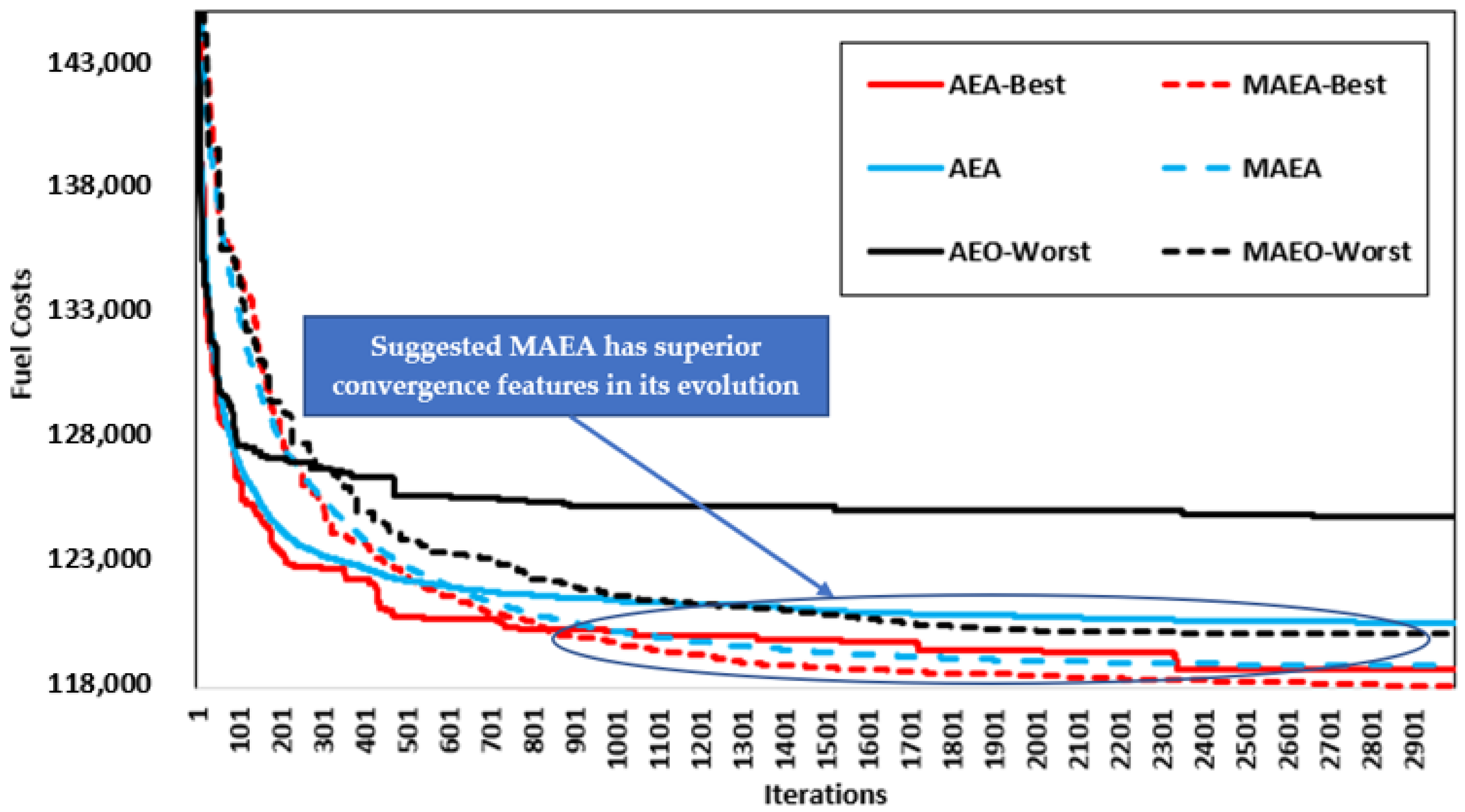

| Outputs | AEA | Proposed MAEA | |
|---|---|---|---|
| Power-only units | Pg 1 | 44.70016 | 44.75768 |
| Pg 2 | 98.56597 | 98.56182 | |
| Pg 3 | 112.681 | 112.6768 | |
| Pg 4 | 209.8095 | 209.8153 | |
| CHP 1 | Pg 5 | 94.24102 | 94.18733 |
| Hg 5 | 26.88296 | 27.18475 | |
| CHP 2 | Pg 6 | 40.00238 | 40.00106 |
| Hg 6 | 74.95064 | 74.99904 | |
| Heat-only unit | Hg 7 | 48.1664 | 47.81621 |
| Costs (USD/h) | 10,092.41375 | 10,092.18153 | |
| Costs (USD/h) | AEO | Proposed MAEA | Improvement % |
|---|---|---|---|
| Minimum | 10,092.41 | 10,092.18 | 0.002301 |
| Mean | 10,108.01 | 10,093.32 | 0.145364 |
| Maximum | 10,186.05 | 10,095.17 | 0.892249 |
| Standard Deviation | 27.37743 | 0.734646 | 97.3166 |
| Outputs | AEA | Proposed MAEA | |
|---|---|---|---|
| Power-only units | Pg 1 | 45.17078 | 45.17078 |
| Pg 2 | 98.53982 | 98.53982 | |
| Pg 3 | 112.6899 | 112.6899 | |
| Pg 4 | 209.8158 | 209.8158 | |
| CHP 1 | Pg 5 | 94.59907 | 94.59907 |
| Hg 5 | 24.72766 | 24.72766 | |
| CHP 2 | Pg 6 | 40 | 40 |
| Hg 6 | 75.00086 | 75.00086 | |
| Heat-only unit | Hg 7 | 50.27148 | 50.27148 |
| Costs (USD/h) | 10,095.12 | 10,095.02 | |
| Costs (USD/h) | AEO | Proposed MAEA | Improvement % |
|---|---|---|---|
| Minimum | 10,095.11736 | 10,095.02453 | 0.000919468 |
| Mean | 10,107.45372 | 10,095.84203 | 0.114882388 |
| Maximum | 10,172.61916 | 10,097.86343 | 0.734872038 |
| Standard Deviation | 23.09259359 | 0.777264037 | 96.63414144 |
| Optimizer | Costs (USD/h) |
|---|---|
| Proposed MAEA | 10,095.02453 |
| AEO | 10,095.11736 |
| TVAC-PSO [38] | 10,100.3000 |
| IGA [39] | 10,107.9071 |
| ECSA [40] | 10,121.9466 |
| PSO [41] | 10,178.4311 |
| TVAC-PSO [41] | 10,244.0200 |
| LCA [42] | 12,451.4000 |
| CPSO [43] | 10,325.3000 |
| WVO-PSO [44] | 10,372.0000 |
| WVO [44] | 10,317.0000 |
| RCGA [45] | 10,667.0000 |
| BCO [45] | 10,317.0000 |
| DE [46] | 10,317.0000 |
| DE [43] | 10,317.0000 |
| Outputs | AEA | Proposed MAEA | Outputs | AEA | Proposed MAEA |
|---|---|---|---|---|---|
| Pg 1 | 448.8807 | 538.5761 | Pg 32 | 40.15046 | 53.42016 |
| Pg 2 | 153.4517 | 224.6881 | Pg 33 | 81.22367 | 105.7268 |
| Pg 3 | 297.4129 | 150.6271 | Pg 34 | 54.23016 | 40.71791 |
| Pg 4 | 159.7331 | 109.8798 | Pg 35 | 159.8071 | 145.7548 |
| Pg 5 | 109.8657 | 159.6088 | Pg 36 | 40.35118 | 58.07748 |
| Pg 6 | 109.8665 | 109.6811 | Pg 37 | 18.34234 | 11.87948 |
| Pg 7 | 159.7313 | 109.9305 | Pg 38 | 58.66311 | 35.5726 |
| Pg 8 | 159.5867 | 111.388 | Hg 27 | 157.8226 | 111.8012 |
| Pg 9 | 109.8644 | 109.9677 | Hg 28 | 77.27785 | 82.64235 |
| Pg 10 | 113.2198 | 77.44919 | Hg 29 | 106.0673 | 115.5393 |
| Pg 11 | 84.37659 | 114.8267 | Hg 30 | 96.1183 | 75.15452 |
| Pg 12 | 69.79648 | 92.7831 | Hg 31 | 40.07545 | 40.54104 |
| Pg 13 | 108.2384 | 55.06172 | Hg 32 | 22.3367 | 28.37245 |
| Pg 14 | 269.1298 | 359.1073 | Hg 33 | 104.9259 | 118.6701 |
| Pg 15 | 18.09279 | 300.7246 | Hg 34 | 87.28232 | 75.61917 |
| Pg 16 | 299.1923 | 299.6896 | Hg 35 | 149.024 | 141.13 |
| Pg 17 | 134.9289 | 109.9425 | Hg 36 | 75.30099 | 90.60269 |
| Pg 18 | 159.7199 | 110.3213 | Hg 37 | 43.57571 | 40.79744 |
| Pg 19 | 133.4154 | 159.7346 | Hg 38 | 30.7564 | 20.25903 |
| Pg 20 | 159.7371 | 109.9029 | Hg 39 | 418.0359 | 419.3306 |
| Pg 21 | 109.4822 | 109.8995 | Hg 40 | 60 | 59.99817 |
| Pg 22 | 109.8535 | 110.3726 | Hg 41 | 59.99961 | 59.02255 |
| Pg 23 | 77.06126 | 77.56081 | Hg 42 | 119.9991 | 119.9959 |
| Pg 24 | 114.9288 | 77.73939 | Hg 43 | 119.896 | 119.9999 |
| Pg 25 | 92.40386 | 72.898 | Hg 44 | 371.5652 | 420.5329 |
| Pg 26 | 109.2187 | 92.54764 | Hg 45 | 59.99897 | 59.99902 |
| Pg 27 | 175.4811 | 93.49093 | Hg 46 | 59.99318 | 59.99546 |
| Pg 28 | 42.63888 | 48.85531 | Hg 47 | 119.9613 | 119.9966 |
| Pg 29 | 83.2744 | 100.1503 | Hg 48 | 119.9873 | 119.9998 |
| Pg 30 | 64.4735 | 40.18019 | Costs (USD/h) | 118,881.4 | 116,897.9 |
| Pg 31 | 10.17506 | 11.26554 |
| Costs (USD/h) | AEO | Proposed MAEA | Improvement % |
|---|---|---|---|
| Minimum | 118,881.4473 | 116,897.8879 | 1.668518838 |
| Mean | 120,045.6955 | 118,004.3493 | 1.70047432 |
| Maximum | 124,396.4722 | 119,424.0332 | 3.997250827 |
| Standard Deviation | 1106.34051 | 597.0478043 | 46.03399236 |
| Optimizer | Best Costs (USD/h) | Mean Costs (USD/h) | Worst Costs (USD/h) |
|---|---|---|---|
| Proposed MAEA | 116,897.8879 | 118,004.3493 | 119,424.0332 |
| AEO | 118,881.4473 | 120,045.6955 | 124,396.4722 |
| GSA [15] | 119,775.9 | - | - |
| MRFO [47] | 117,336.9 | 117,875.4 | 118,217.5 |
| CPSO [41] | 120,918.9 | - | - |
| TVAC-PSO [41] | 118,962.5 | - | - |
| MVO [47] | 117,657.9 | 118,724 | 119,249.3 |
| SSA [47] | 120,174.1 | 121,110.2 | 122,636.8 |
| Outputs | AEA | Proposed MAEA | Outputs | AEA | Proposed MAEA |
|---|---|---|---|---|---|
| Pg 1 | 538.5587406 | 628.6477795 | Pg 32 | 38.76118435 | 63.12739336 |
| Pg 2 | 224.500532 | 299.3039097 | Pg 33 | 88.68870343 | 146.019954 |
| Pg 3 | 224.4082699 | 224.4413162 | Pg 34 | 42.77532917 | 50.56025758 |
| Pg 4 | 159.7326419 | 110.1098241 | Pg 35 | 139.9313947 | 111.1809533 |
| Pg 5 | 109.8653469 | 109.9778609 | Pg 36 | 64.33155077 | 41.38648745 |
| Pg 6 | 110.0410418 | 109.9393484 | Pg 37 | 17.10618711 | 21.37570912 |
| Pg 7 | 159.7343364 | 109.9133488 | Pg 38 | 51.53918299 | 42.68203447 |
| Pg 8 | 109.6188942 | 110.043928 | Hg 27 | 124.6343646 | 116.4793542 |
| Pg 9 | 109.8371821 | 109.938183 | Hg 28 | 104.1938155 | 76.07240708 |
| Pg 10 | 77.4032053 | 48.92271876 | Hg 29 | 104.8875567 | 106.7188473 |
| Pg 11 | 40.00026194 | 77.44715085 | Hg 30 | 100.112622 | 84.40365244 |
| Pg 12 | 92.61659623 | 94.12721908 | Hg 31 | 44.08211567 | 41.31323057 |
| Pg 13 | 69.13694475 | 92.38136273 | Hg 32 | 21.70901773 | 32.76518388 |
| Pg 14 | 538.5591303 | 448.8213154 | Hg 33 | 109.1153478 | 141.283024 |
| Pg 15 | 305.3626551 | 150.3625883 | Hg 34 | 77.39491135 | 84.08846428 |
| Pg 16 | 75.71780424 | 224.5198314 | Hg 35 | 137.8725067 | 121.7181569 |
| Pg 17 | 109.8666626 | 109.8560048 | Hg 36 | 96.0050104 | 76.19104695 |
| Pg 18 | 110.3999059 | 110.5899462 | Hg 37 | 43.04592942 | 44.86858389 |
| Pg 19 | 160.1264504 | 110.0674115 | Hg 38 | 27.51826351 | 23.48428876 |
| Pg 20 | 109.8878115 | 159.7957779 | Hg 39 | 380.963592 | 415.0460685 |
| Pg 21 | 109.8694694 | 109.9903509 | Hg 40 | 59.96320817 | 59.86965016 |
| Pg 22 | 109.8484983 | 160.5171237 | Hg 41 | 59.99673171 | 59.97150217 |
| Pg 23 | 97.5173401 | 77.50518542 | Hg 42 | 119.9998655 | 119.9989975 |
| Pg 24 | 77.40055945 | 77.50615461 | Hg 43 | 119.9938832 | 119.7248381 |
| Pg 25 | 92.63089118 | 92.55833553 | Hg 44 | 408.8797 | 416.2126319 |
| Pg 26 | 92.41551521 | 92.7814134 | Hg 45 | 59.99971606 | 59.98718434 |
| Pg 27 | 116.3421498 | 101.8906582 | Hg 46 | 59.9999997 | 59.85924821 |
| Pg 28 | 73.81758739 | 41.24267045 | Hg 47 | 119.6365482 | 119.9649134 |
| Pg 29 | 81.15521833 | 84.45117414 | Hg 48 | 119.9952941 | 119.9787256 |
| Pg 30 | 69.0898591 | 50.89534319 | Costs (USD/h) | 118,793.8535 | 118,134.9569 |
| Pg 31 | 19.52394366 | 13.06729569 |
| Costs (USD/h) | AEO | Proposed MAEA | Improvement % |
|---|---|---|---|
| Minimum | 118,793.8535 | 118,134.9569 | 0.554655419 |
| Mean | 120,660.8568 | 118,925.8259 | 1.437940105 |
| Maximum | 125,071.3754 | 120,226.6133 | 3.87359788 |
| Standard Deviation | 1241.686276 | 489.6017384 | 60.56961023 |
Publisher’s Note: MDPI stays neutral with regard to jurisdictional claims in published maps and institutional affiliations. |
© 2022 by the authors. Licensee MDPI, Basel, Switzerland. This article is an open access article distributed under the terms and conditions of the Creative Commons Attribution (CC BY) license (https://creativecommons.org/licenses/by/4.0/).
Share and Cite
Mahdy, A.; El-Sehiemy, R.; Shaheen, A.; Ginidi, A.; Elbarbary, Z.M.S. An Improved Artificial Ecosystem Algorithm for Economic Dispatch with Combined Heat and Power Units. Appl. Sci. 2022, 12, 11773. https://doi.org/10.3390/app122211773
Mahdy A, El-Sehiemy R, Shaheen A, Ginidi A, Elbarbary ZMS. An Improved Artificial Ecosystem Algorithm for Economic Dispatch with Combined Heat and Power Units. Applied Sciences. 2022; 12(22):11773. https://doi.org/10.3390/app122211773
Chicago/Turabian StyleMahdy, Araby, Ragab El-Sehiemy, Abdullah Shaheen, Ahmed Ginidi, and Zakaria M. S. Elbarbary. 2022. "An Improved Artificial Ecosystem Algorithm for Economic Dispatch with Combined Heat and Power Units" Applied Sciences 12, no. 22: 11773. https://doi.org/10.3390/app122211773
APA StyleMahdy, A., El-Sehiemy, R., Shaheen, A., Ginidi, A., & Elbarbary, Z. M. S. (2022). An Improved Artificial Ecosystem Algorithm for Economic Dispatch with Combined Heat and Power Units. Applied Sciences, 12(22), 11773. https://doi.org/10.3390/app122211773









